Japanese educational system provides children with certain quality education across the board and maintains high enrollment rates. Japanese students consistently rank highly among OECD students in terms of quality and performance in reading literacy, mathematics, and science.
Some special features of Japanese-Style Education are
-
- Holistic education approach with solid academic ability, rich humanity and a healthy body throughout the entire school life including not only lessons but also extracurricular activities.
- Quality teachers who are continuously upgrading their teaching skills through systematic teacher trainings and in-house trainings with lesson studies.
- Colleges of technology, KOSEN, develop engineers so they will have practical and sophisticated skills.
Websites
■ MEXT’s Health and Hygiene Information Website for Schools for Foreign Students
This website provides information on health and hygiene including novel coronavirus to young Japanese learners in schools for foreign students, their guardians, and education providers in schools for foreign students.
■ Study in Japan
This site is a government-approved information site for studying in Japan operated by the Japan Student Services Organization in cooperation with the Ministry of Education, Culture, Sports, Science and Technology and the Ministry of Foreign Affairs.
■ JICA(Japan International Cooperation Agency)’s Website on Educational Cooperation
https://www.jica.go.jp/english/activities/issues/education/index.html
(Education : Introduction of Japan’s educational cooperation )
https://www.jica.go.jp/english/activities/issues/education/materials/index.html
(Materials : Teaching and reference materials that can be used as learning materials for children with foreign backgrounds)
Pamphlet
-
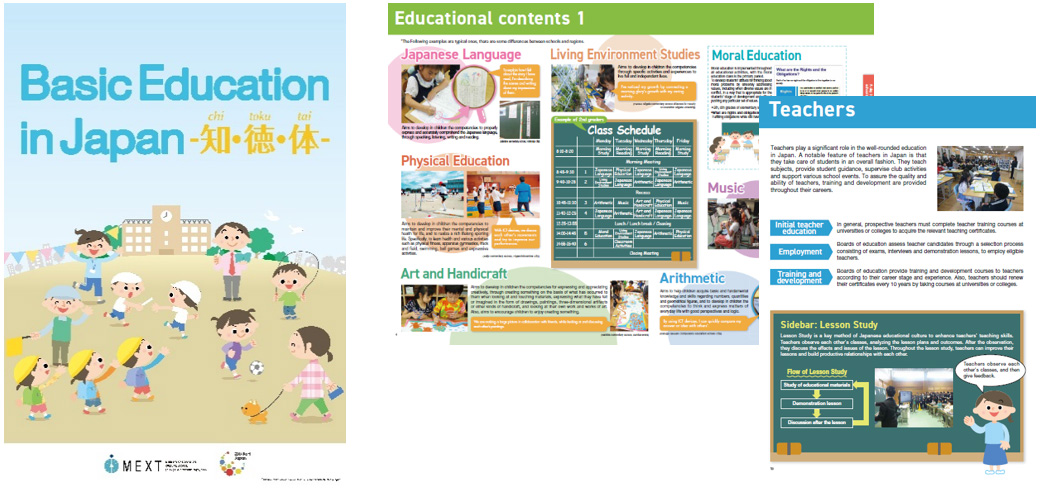
This pamphlet introduces basic education in Japan with illustrations and pictures.
-
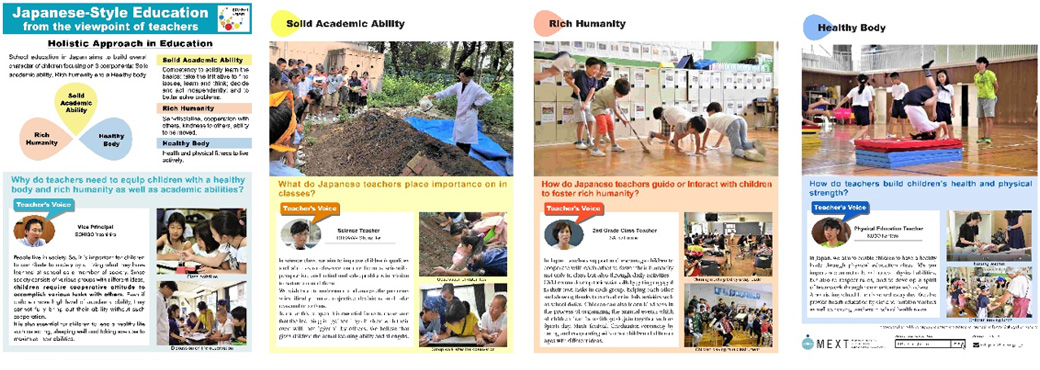
This leaflet introduces the characteristics of Japanese-style education from the viewpoint of teachers.
-
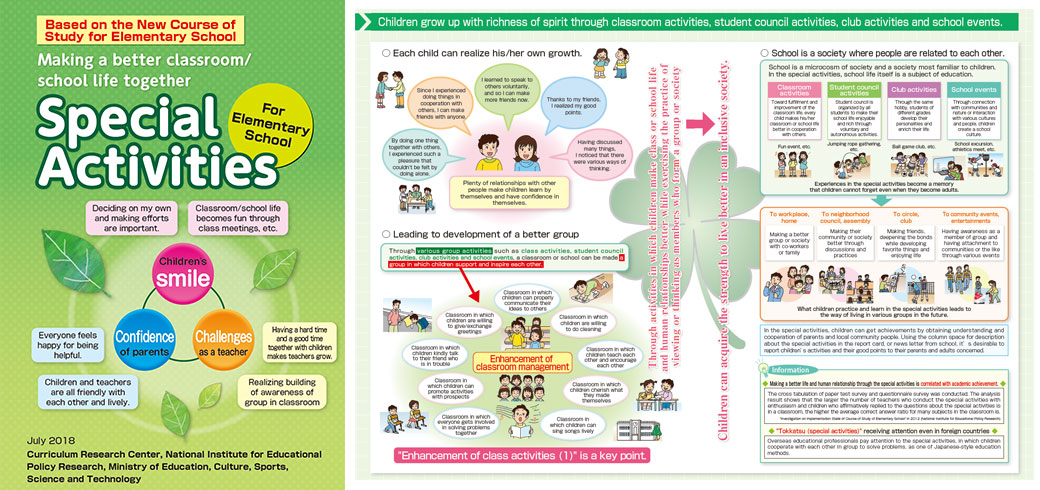
This pamphlet is originally developed for elementary school teachers in Japan, aiming to provide teachers with practical methods to conduct effective “Special Activities”* in schools. Overseas educational professionals pay attention to “Special Activities”, in which children cooperate with each other in group to solve problems, as one of the Japanese-style education methods.
*Special Activities for elementary school are composed of classroom activities, student council activities, club activities and school events.
-
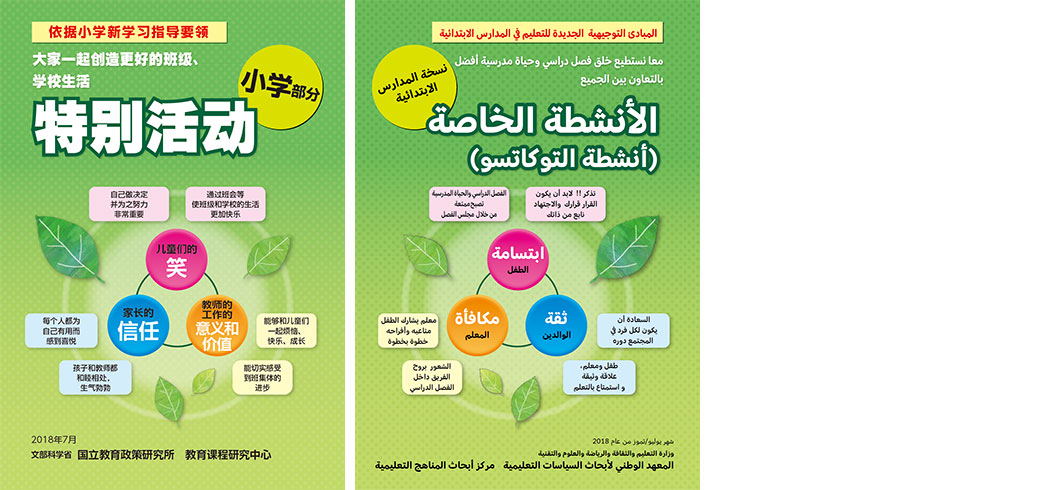
Making a better classroom/school life together Special Activities For Elementary School
(Published by Curriculum Research Center, National Institute for Educational Policy Research, Ministry of Education, Culture, Sports, Science and Technology, July 2018)
-

MEXT has published a brochure providing an overview of MEXT’s initiatives against the COVID-19 pandemic in the field of education.
MEXT is taking whatever measures necessary to ensure children’s quality learning, leaving no one behind.
Data on Japanese Education
-

This is an excerpt from “Overview of the Ministry of Education, Culture, Sports, Science and Technology”. It shows various data on budget, school systems, public expenditure on education, number of schools/students/teachers and percentages of entering higher education institutions.
Videos
■ Holistic education approach with Solid academic ability, Rich humanity and a Healthy body
■ One day of elementary school students in Japan
This animation video introduces Japanese-style education at elementary school level.
Subtitles in multiple languages provided
■ Video materials on Special Activities for elementary schools
National Institution for Educational Policy Research has developed a series of video materials on classroom activities as a part of Special Activities for elementary schools in Japan. The materials are composed of 17 videos (Japanese version) in the following 3 parts:
What are Classroom Activities (1): to develop the self-governing ability
What are Classroom Activities (2): to develop the ability to work proactively and persistently toward solving one’s life issues
What are Classroom Activities (3): to develop the ability to realize self-actualization
The following are the pamphlet to explain the contents of the 17 videos and 3 videos translated into English.
-
Pamphlet for introducing video materials (English version)
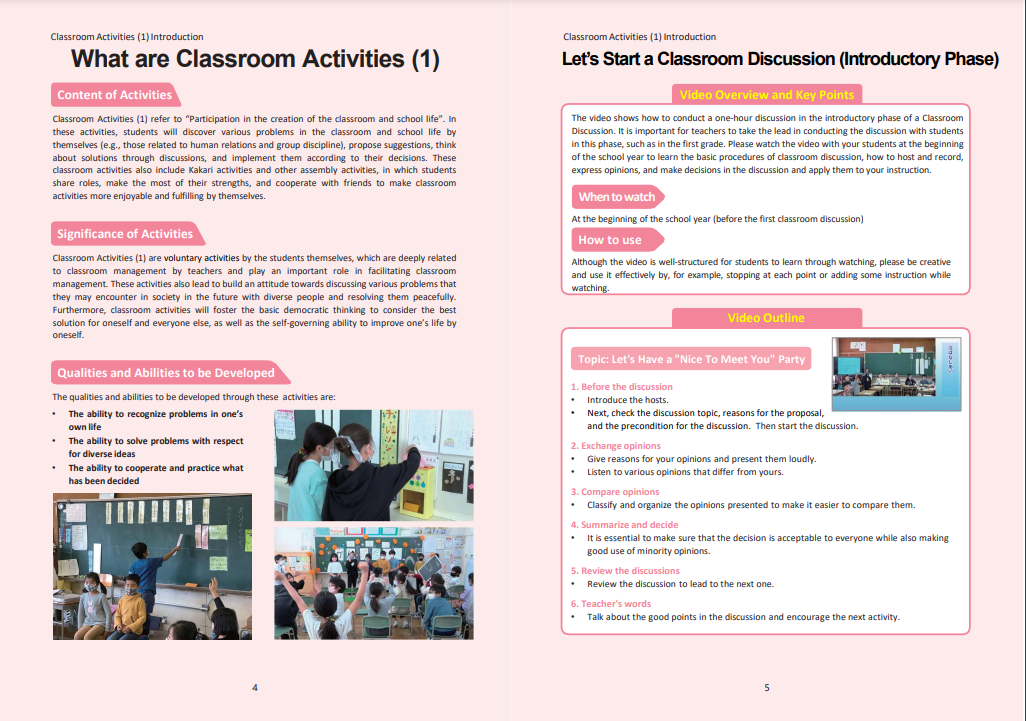
The pamphlet gives explanations of each videos (17 videos in total) including overview, key points, and outline.
Click here to read the pamphlet. -
Let’s Get Started with Kakari Activities
Students’ creative activities are essential to fostering a fun and productive classroom life. This video explains the significance of classroom activities, how they are implemented, and what ultimately motivates them.
-
Classroom Discussion
Based on the video materials for students, “Let’s Get Started with Kakari Activities”, and “Let’s hold a Classroom Assembly”, this video highlights the key points to pay attention to when giving instructions on classroom task activities and classroom assembly activities. -
Toban Tasks
By thinking about the significance of Toban tasks, students can take the initiative to do these Toban tasks as class members.
■ “Our School Life in Japan”
In FY2022, EDU-Port Japan invited short videos that would provide overseas children, educators, and others interested in Japanese education with an insight into “daily life at school” in Japan. Here are some videos produced by the organizations conducting EDU-Port Japan Projects and their collaborating schools.
Note: All the ideas and content provided on this section are not supervised or edited by MEXT.
■ A Day to Remember
Produced by Social Welfare Corporation Tanenokai, Arte Children and Tree KindergartenAt our kindergarten, we place great importance on teaching children about Japanese culture and traditional events, as well as having them experience them firsthand. This video introduces one such event, the celebration of Hinamatsuri (Girls’ Day).
■ The School Health Checkup of a Small Primary School in the Countryside of Japan
Produced by Kagawa UniversityIn Japanese schools, all children from kindergarten to university have the school health checkup at the beginning of the academic year by law. This video shows you a part of the school health checkup and school health in the countryside of Japan.
■ What “Inquiry” is useful for all of us? -Our thoughts on “Inquiry”-
Produced by Seto SOLAN Primary School (Grade 2 student’s group: Riku-Tora-Bun)“Inquiry” is learning created by learners themselves. Learning ability to cultivated by this type of learning will be fundamental to create a better society when they become adults. The students who have a research question; “What videos can be watched by many people?” produced this video. They introduce methods and significance of the “Inquiry” in this video.
■ Introduction of Physical Education Lesson
Produced by Hachimantai Municipal Tairadate Elementary School in Iwate PrefectureThe goal of PE lessons at our school is to make fitness fun and to inspire the students to develop a love of all kinds of physical exercise. This video introduces how to plan a PE lesson.
■ Morning Scene, Mathematics Lesson, and Club Activity
Produced by Higashiyama Junior High school・High School“Greeting” is important in schools in Japan to nurture the attitude respecting each other. This video shows a morning greeting scene, mathematics lesson of our school, and the club activity after class.
■ Japanese High School Explained
Bunkyo Gakuin University Girls Junior Senior High SchoolThis is a short movie to explain one of the private girls’ high schools in Tokyo, which was founded about a hundred years ago. It presents an example about what a Japanese private school looks like.
■ School Lunch before and after COVID-19 Pandemic
School Lunch before COVID-19 Pandemic [YouTube]
School Lunch after COVID-19 Pandemic [YouTube]
Produced by Bunkyo Gakuin University Girls Junior Senior High School
Our junior high school offers school lunch but we had to change the way of serving lunch due to COVID-19 pandemic. This is an example of how to prevent an infectious disease from spreading during school lunch.
Other resouces
The following links are the content gathering attention to explore the characteristics of Japanese education.
Note: All the ideas and content provided on this section are not supervised or edited by MEXT.
■ School lunch
Produced by Atsuko Quirk CafeteriaCulture.org
http://www.cafeteriaculture.org/







